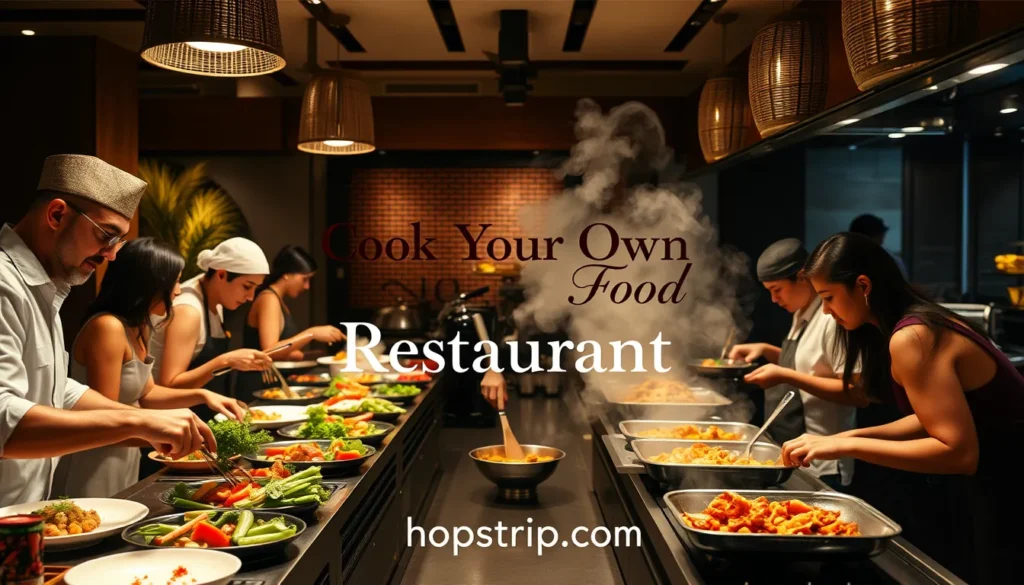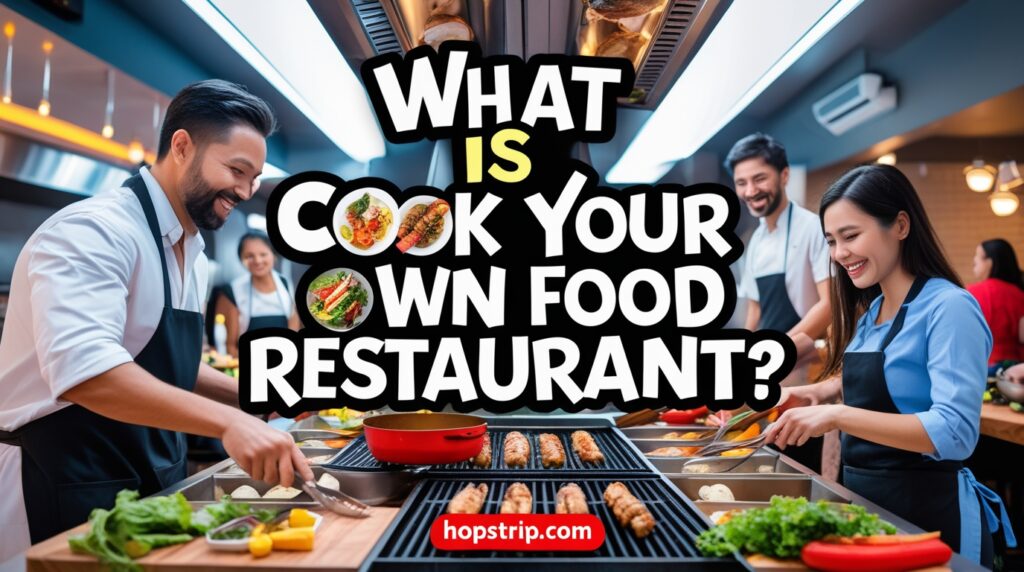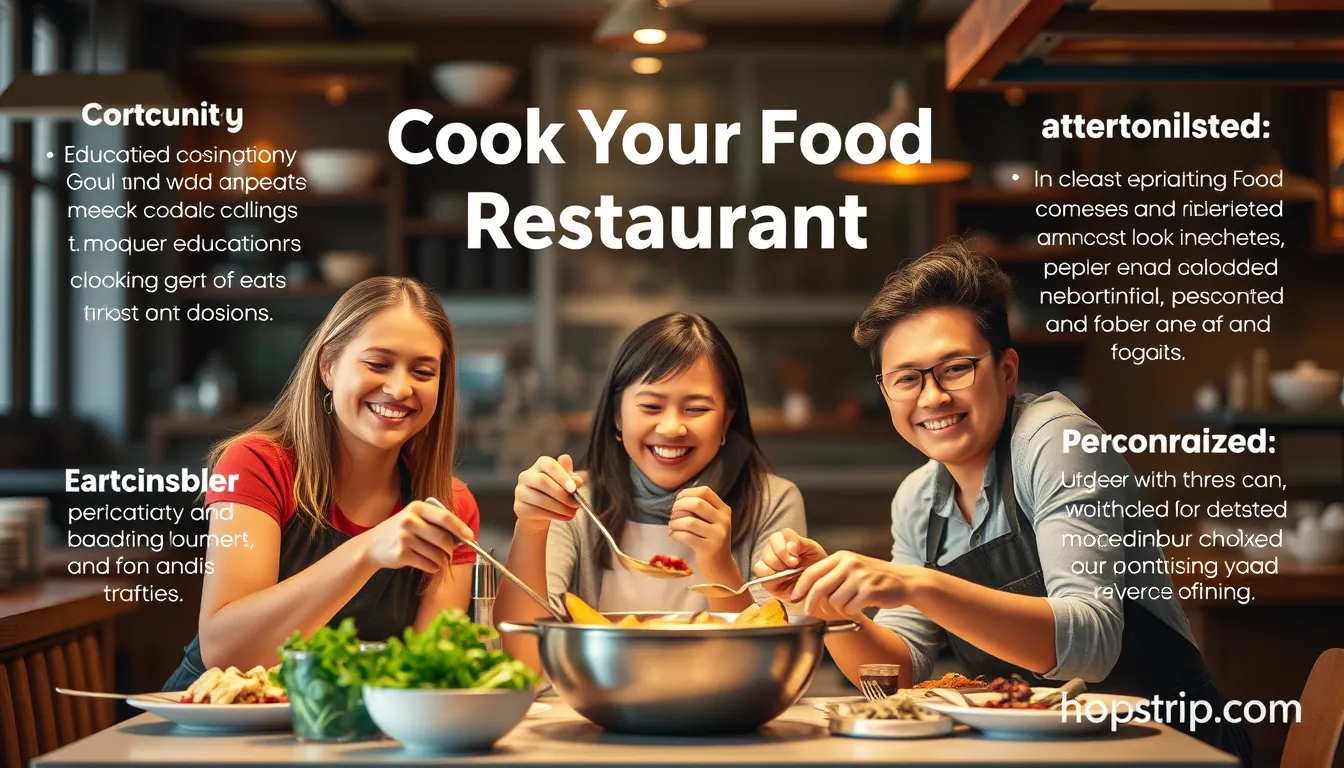Table of Contents
The Rise of Cook-Your-Own-Food Restaurant Experiences

A fascinating dining trend is sweeping across the culinary landscape, transforming the traditional restaurant experience into an interactive adventure. Imagine stepping into a restaurant where you become the chef, taking control of your culinary destiny while enjoying the ambiance of professional dining establishment.
Interactive Dining Experience
At Benihana and similar establishments, guests participate in preparing their meals at specially designed cooking stations. These restaurants provide fresh, pre-portioned ingredients and necessary cooking equipment, allowing diners to create their perfect dish. The concept combines the convenience of dining out with the satisfaction of cooking your own meal.
Understanding the Concept
These innovative dining venues typically feature individual cooking stations equipped with built-in grills, hot plates, or specialized cooking equipment. Each station includes proper ventilation systems and safety features, ensuring a comfortable cooking experience. Trained staff members provide guidance and assistance, making it accessible even for novice cooks.
Popular Cooking Styles
• Korean BBQ: Grill your own meats and vegetables at the table • Hot Pot: Cook ingredients in flavorful broths • Teppanyaki: Cook on flat iron griddles • Stone Grill: Prepare foods on heated volcanic stones • DIY Pizza: Create and bake your own perfect pie
Benefits of Interactive Dining
Cook-your-own-food restaurants offer unique advantages that traditional dining can’t match:
• Complete control over food preparation • Fresh ingredients selected by you • Customizable portions and seasoning • Educational cooking experience • Enhanced social interaction • Entertainment value
Safety and Support Systems
Professional establishments like The Melting Pot implement comprehensive safety measures to ensure a secure cooking experience. Staff members provide detailed instructions and monitor cooking activities, while sophisticated ventilation systems maintain air quality. Emergency protocols and proper equipment handling guidelines are always in place.
Educational Components
Many venues offer mini cooking lessons before guests begin their culinary adventure. These brief tutorials cover:
• Proper cooking temperatures • Food safety guidelines • Ingredient handling techniques • Cooking time recommendations • Flavor pairing suggestions
Social Impact and Dining Culture
This interactive dining concept has revolutionized social gathering experiences. Groups can bond over shared cooking responsibilities, creating memorable moments while preparing their meals together. It’s particularly popular for:
• Team building events • Date nights • Family gatherings • Special celebrations • Social meetups
Technology Integration
Modern cook-your-own-food restaurants incorporate technology to enhance the experience. Digital cooking guides, temperature monitors, and timer systems help ensure optimal results. Some venues even offer tablet-based recipe suggestions and cooking tutorials at each station.
Market Growth and Future Trends
The industry continues to evolve with innovative concepts and fusion experiences. Market research indicates a steady increase in demand for interactive dining experiences, particularly among millennials and Gen Z consumers who value experiential dining options.
| Year | Market Growth | Popular Concepts |
|---|---|---|
| 2021 | 15% | Korean BBQ, Hot Pot |
| 2022 | 22% | DIY Sushi, Stone Grilling |
| 2023 | 28% | Fusion Concepts, Virtual Guidance |
These establishments represent more than just a dining trend; they’re creating a new category in the restaurant industry that combines entertainment, education, and culinary excellence. As consumers continue seeking unique dining experiences, cook-your-own-food restaurants are positioned to remain at the forefront of innovative hospitality concepts.
Benefits of Interactive Dining Experiences

The Rise of Cook-Your-Own Food Restaurants
Have you ever wanted to be both the chef and diner at your restaurant table? Cook-your-own food restaurants are revolutionizing the dining scene by putting you in control of your culinary experience. These innovative establishments provide fresh ingredients and cooking equipment right at your table, letting you prepare meals exactly to your taste while enjoying a unique social atmosphere.
Creating Your Perfect Meal
At cook-your-own food restaurants, you’ll find everything needed to craft your ideal dish. From Korean BBQ venues where you grill marinated meats to perfection, to hot pot establishments where you simmer fresh vegetables and proteins in flavorful broths, the possibilities are endless. These restaurants typically provide:
• Premium raw ingredients • Tableside cooking equipment • Signature sauces and seasonings • Expert guidance from staff • Cooking tools and utensils
A Social Dining Adventure
The interactive nature of these restaurants transforms ordinary meals into memorable social events. Whether you’re on a date, celebrating with family, or enjoying a night out with friends, cooking together creates natural conversation and shared experiences. Many venues feature specially designed tables with built-in grills or burners, making the cooking process comfortable and convenient.
Health and Dietary Benefits
When you cook your own food at restaurants, you gain complete control over:
• Portion sizes • Cooking methods • Ingredient combinations • Seasoning levels • Food allergen management
This level of control makes these establishments ideal for health-conscious diners and those with dietary restrictions. You can watch your meal being prepared from start to finish, ensuring it meets your specific requirements.
Cultural Learning Experience
Many cook-your-own food restaurants showcase traditional cooking methods from various cultures. Whether it’s Japanese Shabu-shabu or Swiss raclette, these venues offer an immersive cultural experience. You’ll learn authentic cooking techniques while enjoying time-honored traditions from around the world.
Cost-Effective Quality Dining
These restaurants often provide excellent value for money. Since you’re handling the cooking, labor costs are lower, allowing establishments to offer premium ingredients at reasonable prices. Many venues operate on an all-you-can-eat model, letting you sample various ingredients while perfecting your cooking skills.
Safety and Support
While you’re in charge of cooking, you’re never truly alone. Trained staff members provide:
• Initial cooking demonstrations • Safety instructions • Temperature guidance • Recipe suggestions • Ongoing assistance as needed
Environmental Considerations
Cook-your-own restaurants often contribute to reducing food waste. Since you control portion sizes and cooking amounts, there’s typically less leftover food compared to traditional restaurants. Many establishments also use energy-efficient cooking equipment and sustainable ingredients, making them an environmentally conscious dining choice.
Remember to consider any special dietary restrictions or food allergies when visiting these venues. While most restaurants accommodate various dietary needs, it’s always best to check in advance. With proper planning and an adventurous spirit, cook-your-own food restaurants offer an exciting alternative to traditional dining experiences, combining entertainment, education, and excellent food in one memorable package.
Popular Cooking Styles and Equipment in DIY Restaurants

Equipment Essentials for DIY Cooking
The rise of cook-your-own-food restaurants has introduced diners to various cooking equipment and techniques. At the heart of these interactive dining venues, you’ll find specialized tools designed for different cooking methods. Professional-grade equipment ensures food safety while providing an authentic cooking experience.
Traditional tabletop grills dominate Korean BBQ establishments, featuring adjustable heat settings and efficient ventilation systems. These grills often come with specialized grates designed for specific meat cuts and vegetables. Japanese hot pot restaurants typically provide individual induction cooktops with precise temperature controls, allowing you to maintain the perfect simmer for your broth.
Popular Cooking Methods
Hot Pot Experience
Hot pot cooking involves a simmering pot of broth where you cook various ingredients. This style originated in China but has spread globally, with different regions offering unique broths and ingredients. Modern hot pot restaurants feature divided pots, allowing you to enjoy two different broths simultaneously. Common ingredients include:
• Thinly sliced meats • Fresh vegetables • Noodles • Seafood • Tofu varieties • Mushrooms
Korean BBQ Style
Korean BBQ emphasizes the art of grilling meats and vegetables directly at your table. Many establishments provide specialized tongs and scissors for handling and cutting meat. The cooking process typically follows this order:
- Preheat the grill
- Oil the cooking surface
- Grill meat in small batches
- Add vegetables alongside
- Use provided dipping sauces
Safety Measures and Controls
DIY cooking restaurants implement strict safety protocols to ensure a secure dining experience. Food safety guidelines are prominently displayed, and staff members provide thorough instructions before cooking begins. Modern ventilation systems prevent smoke accumulation, while temperature-controlled cooking surfaces prevent overcooking.
Timer systems help track cooking duration for different ingredients, especially in hot pot settings where timing is crucial for food safety. Many establishments utilize color-coded plates to distinguish raw from cooked items, preventing cross-contamination.
Regional Cooking Variations
Different regions offer unique DIY cooking experiences. Brazilian churrascarias sometimes feature personal grilling stations, while Japanese teppanyaki restaurants provide individual flat-top grills. Mongolian BBQ venues offer large circular griddles where you can cook your chosen ingredients with guidance from experienced chefs.
Some innovative establishments combine multiple cooking styles, offering:
• Table-mounted steamers • Personal hibachi grills • Specialized fondue equipment • Stone cooking surfaces • Infrared cooking technology
Technical Features
Modern cook-your-own-food restaurants incorporate advanced features for better dining experiences. Digital temperature displays, preset cooking programs, and built-in timers help ensure perfect results. Some venues even offer tablet-based ordering systems with cooking instructions and timer management.
Ventilation systems have evolved to include:
• Downdraft extraction • Overhead hoods with LED lighting • Multi-stage filtration • Smart sensors for smoke detection • Automatic fan speed adjustment
These technological advances enhance the dining experience while maintaining safety standards. Restaurant technology solutions continue to evolve, making DIY cooking more accessible and enjoyable for diners of all experience levels.
Safety Measures and Customer Guidelines
Ensuring a Safe and Enjoyable Cooking Experience
When you step into a cook your own food restaurant, understanding proper safety measures is crucial for an enjoyable dining experience. These establishments require customers to handle raw ingredients and cooking equipment, making safety awareness essential.
Before starting your culinary adventure, carefully wash your hands at the designated stations. Most restaurants provide sanitizing stations equipped with antibacterial soap and paper towels. Remember to repeat this process whenever you handle different types of food, especially raw meat.
Essential Kitchen Safety Protocols
The cooking area demands special attention to prevent accidents. Keep these vital safety measures in mind:
• Wear the provided protective gear, including aprons and heat-resistant gloves • Keep long hair tied back and avoid loose clothing • Use designated utensils for raw and cooked foods • Follow the marked walking paths to avoid collisions with other guests • Keep children under close supervision at all times
Food Handling Requirements
Cross-contamination prevention is paramount in these establishments. Always use separate cutting boards and utensils for different food types. Many restaurants use color-coded equipment – red for raw meat, green for vegetables, and white for cooked foods.
Visit the Food Safety Information website to learn more about proper food handling techniques and temperature requirements for different ingredients.
Temperature Control Guidelines
Understanding proper cooking temperatures ensures food safety:
• Beef, lamb, and pork: 145°F (63°C) • Ground meats: 160°F (71°C) • Poultry: 165°F (74°C) • Fish and seafood: 145°F (63°C)
Most restaurants provide digital thermometers at cooking stations. Don’t hesitate to ask staff members for guidance on using these tools correctly.
Emergency Procedures
Familiarize yourself with emergency protocols before cooking. Look for:
• Location of fire extinguishers • Emergency exits • First aid stations • Staff call buttons at cooking stations
The National Fire Protection Association provides comprehensive guidelines for kitchen fire safety that many restaurants follow.
Personal Responsibility Requirements
Customers must acknowledge and follow these essential guidelines:
• Sign the required liability waiver • Report any equipment malfunctions immediately • Clean cooking stations after use • Dispose of waste in designated containers • Follow staff instructions promptly
Many establishments use surveillance systems to ensure compliance with safety protocols. Some restaurants require watching a brief safety video before cooking, particularly for first-time visitors.
Special Considerations
Inform staff about any allergies or dietary restrictions before cooking. Most restaurants maintain detailed ingredient lists and can provide alternative cooking stations for guests with severe allergies. Some locations offer specialized equipment for vegetarian and vegan customers to prevent cross-contamination.
Remember that while cook your own food restaurants provide an exciting dining experience, they also require heightened awareness and responsibility. Staff members are trained to assist and guide you through the process, ensuring both safety and enjoyment during your visit.
For additional guidance, check the ServSafe website, which provides comprehensive food safety training resources used by many restaurants nationwide. Always prioritize safety over speed when preparing your meal, and don’t hesitate to ask for assistance when needed.
Global Trends and Future of Participatory Dining
The restaurant industry is witnessing a remarkable shift as cook-your-own-food establishments gain popularity worldwide. This innovative dining concept, where customers become their own chefs, has transformed from a novelty into a significant trend that’s reshaping the culinary landscape.
Interactive Dining Revolution
The surge in participatory dining experiences reflects changing consumer preferences and a growing desire for unique entertainment. According to Restaurant Business Online, 73% of millennials prefer experiences over traditional dining. These venues combine the thrill of cooking with the social aspects of dining out, creating memorable experiences that standard restaurants can’t match.
DIY Culinary Concepts
Modern cook-your-own-food restaurants come in various formats:
• Korean BBQ stations with built-in grills • Hot pot venues with customizable broths • Pizza-making workshops • Hibachi-style cooking tables • Interactive sushi-rolling stations
Technology Integration
Smart cooking stations are revolutionizing the participatory dining scene. Restaurants are incorporating:
• Digital recipe displays • Temperature-controlled cooking surfaces • Timer systems for perfect results • Mobile app integration for ordering and cooking guidance • Virtual chef assistance
Economic Impact
The cook-your-own-food restaurant model presents unique business advantages:
| Aspect | Benefit |
|---|---|
| Labor Costs | 20-30% reduction in kitchen staff expenses |
| Customer Engagement | 40% increase in average visit duration |
| Return Rate | 35% higher than traditional restaurants |
Safety and Training Protocols
Leading establishments like Benihana have developed comprehensive safety protocols:
• Mandatory safety briefings • Heat-resistant cooking surfaces • Expert staff supervision • Specialized ventilation systems • Regular equipment maintenance
Cultural Impact and Learning
These venues serve as informal cooking schools, teaching customers about:
• International cooking techniques • Ingredient selection • Food safety practices • Proper tool handling • Traditional cooking methods
The educational aspect has become particularly valuable as 68% of customers report learning new cooking skills during their visits.
Sustainability Focus
Modern cook-your-own-food establishments are embracing eco-friendly practices:
• Locally sourced ingredients • Portion control systems • Minimal food waste • Energy-efficient equipment • Composting programs
Market Evolution
The global cook-your-own-food restaurant sector is experiencing significant growth:
• Annual market growth rate of 12.3% • Expansion into suburban areas • Integration with food delivery platforms • Development of hybrid concepts • Investment in automated systems
Industry experts from Restaurant Dive predict that by 2025, participatory dining will represent 15% of the casual dining market.
This dining revolution reflects a broader cultural shift toward experiential consumption and hands-on learning. As technology advances and consumer preferences evolve, cook-your-own-food restaurants are positioned to become an increasingly significant part of the global dining landscape, offering unique combinations of entertainment, education, and culinary excellence.
Conclusion
Cook-your-own-food restaurants have revolutionized the dining landscape by transforming passive diners into active participants in their culinary journey. As more people seek unique experiences beyond traditional restaurant settings, these interactive establishments continue to gain popularity worldwide. The combination of entertainment, education, and dining creates lasting memories that extend far beyond the typical restaurant visit.
The success of these venues lies in their ability to cater to modern diners’ desires for authenticity, engagement, and personalization. Whether you’re grilling Korean BBQ, cooking hot pot dishes, or assembling your own tacos, these restaurants offer a level of customization and involvement that traditional dining simply cannot match. The social aspect of cooking together has proven particularly appealing to families, friend groups, and even corporate teams looking for unique bonding experiences.
While safety protocols and proper guidance remain paramount, restaurants have successfully implemented comprehensive training systems and safety measures that make the experience both fun and secure. The careful balance of providing freedom to cook while maintaining professional oversight has helped these establishments thrive and expand their reach.
Looking ahead, the cook-your-own-food restaurant concept shows no signs of slowing down. With new technologies emerging and cultural food barriers continuing to break down, we can expect to see even more innovative approaches to interactive dining. These restaurants have found their place in the culinary world by offering something truly special – the chance to be both chef and diner in one memorable experience.
FAQs About Cook Your Own Food Restaurants

1. What is a Cook Your Own Food Restaurant?
A Cook Your Own Food Restaurant is a dining experience where guests prepare their own meals using fresh ingredients and in-table cooking equipment like grills, hot pots, or stone grills.
2. What are the benefits of eating at a Cook Your Own Food Restaurant?

These restaurants offer complete control over food preparation, fresh ingredients, customizable meals, a fun social experience, and a hands-on way to learn new cooking skills.
3. What types of food can you cook at these restaurants?
Popular cooking styles include Korean BBQ, hot pot, teppanyaki, stone grilling, DIY pizza, and fondue, offering a variety of global flavors.
4. Are Cook Your Own Food Restaurants safe?
Yes! They have built-in ventilation, trained staff for assistance, food safety guidelines, and temperature-controlled cooking stations to ensure a secure experience.
5. Do you need cooking experience to dine at these restaurants?
Not at all! Staff members provide guidance, cooking tips, and safety instructions to help beginners enjoy the experience.
6. How much does it cost to eat at a Cook Your Own Food Restaurant?
Prices vary, but many offer all-you-can-eat options or fixed-price menus, making them affordable while providing premium ingredients.
7. Is a Cook Your Own Food Restaurant good for group dining?
Absolutely! These restaurants are perfect for date nights, family gatherings, corporate events, and social meetups, making dining more interactive and fun.
8. Can you customize meals to fit dietary restrictions?
Yes! You control the ingredients, portion sizes, and seasonings, making it ideal for people with food allergies, dietary preferences, or special meal plans.
9. What should I bring when visiting a Cook Your Own Food Restaurant?
Most restaurants provide everything needed, but it’s good to wear comfortable clothing, tie back long hair, and check the menu for dietary options in advance.
10. Where can I find the best Cook Your Own Food Restaurants?
Cook Your Own Food Restaurants are popular worldwide, especially in major cities with strong food cultures like New York, Los Angeles, Seoul, and Tokyo. Check local reviews for top-rated spots near you!

